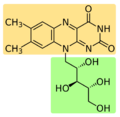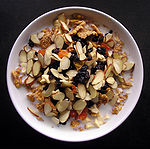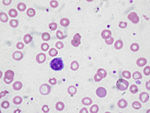| Riboflavin |
  |
| General |
| Systematic name |
7,8-dimethyl-10-
[(2R,3R,4S)-2,3,4,5-tetrahydroxypentyl]
benzo[g]pteridine-2,4-dione |
| Other names |
Vitamin B2
Lactoflavine Vitamin G
Beflavine
Flavaxin
|
| Molecular formula |
C17H20N4O6 |
| Molar mass |
Molar mass:: 376.36 g/mol |
| Appearance |
Orange Needles, Yellow Gold Powder |
| CAS number |
CAS number::83-88-5 |
| Properties |
| Phase |
Solid |
| Solubility in water |
0.1 g/L (25°C) |
| Melting point |
Melting point::290°C |
| Decomposition |
Decomposition::280°C |
| Hazards |
| MSDS |
Material safety data sheet |
| Main hazards |
May cause skin, eye, and respiratory tract irritation |
| NFPA 704 |
|
| Flash point |
Not applicable |
| R/S statement |
R: 36/37/38
S: 26, 37/39 |
| RTECS number |
VJ1400000 |
| Related Compounds |
| Vitamin B Complex |
Thiamine (B1)
Niacin (B3)
Pantothenic acid (B5)
Pyridoxine (B6)
Biotin (B7)
Folic acid, folate (B9)
Cobalamin (B12)
|
Except where noted otherwise, data are given for
materials in their standard state (at 25 °C, 100 kPa)
Disclaimer and references |
Riboflavin, or Vitamin B2, is an essential nutrient for the human body that helps the metabolism of carbohydrates and proteins at the molecular level. Its name is derived from the word flavius, which in Latin means "yellow".[1] Riboflavin is found in many different kinds of food as well as multi-vitamin supplements. Deficiency in riboflavin, known as ariboflavinosis, usually occurs due to poor intake of healthy food and a balanced diet; this condition however, is easily remedied as it is not life-threatening.
Properties
Pure Vitamin B2 is a fluorescent, yellow-green compound that forms yellow/orange crystals in the shape of needles. It is mildly soluble in alcohol, but is insoluble in other substances like chloroform, benzene, and ether. Large amounts of riboflavin give off a bitter taste, so in commercial use, riboflavin is frequently covered in fat to counteract this problem. [2] Riboflavin is a light sensitive substance, but is stable in heat. [3] Vitamin B2, along with all other B-vitamins, is soluble in water and is not stored or produced in the body.
Bodily Functions
Riboflavin's importance rests in its function within the body. It aids in the processes of the nervous system and is vital in maintaining the health of the liver, skin, eyes, and hair. Riboflavin also acts as an antioxidant against harmful particles known as free radicals; by neutralizing the particles, riboflavin prevents damage to DNA and cells. Other roles that this vitamin plays in the body are the breakdown of carbohydrates into glucose and the metabolism of proteins and fat. [4] Riboflavin is a chief part of flavin adenine dinucleotide (FAD) and flavin mononucleotide (FMN), coenzymes that are part of the reactions necessary for fat, carbohydrate, and protein metabolism. These flavocoenzymes also help to process drugs and toxins. Enzymes reliant on FAD and FMN are necessary in converting and catalyzing reactions involving other vitamins such as folic acid, Vitamin B6, and niacin. [5] Riboflavin is also involved in the synthesis of DNA, the production of energy in mitochondria from glucose, and the creation of red blood cells. [6]
Occurrences

This breakfast cereal with almonds and milk is a great source of riboflavin.
Riboflavin is chiefly found in organ meats, dairy products (eggs, milk, and yogurt), whole grains, brewer's yeast, soybeans, almonds, and greeny vegetables (spinach, broccoli, and brussel sprouts). Vitamin B2 supplements are usually part of B-complex vitamins and multivitamins, although they can be taken separately as well. Due to its high light-sensitivity, foods containing riboflavin can lose the vitamin if exposed to light or kept in clear containers. Riboflavin can also be lost if its food source is soaked or boiled in water.[7] To retain the riboflavin in vegetables, they should be cooked in the least amount of water possible, and meats should be broiled or roasted.
Many flours are enriched with riboflavin because it is lost in processing; these flours are then used in various breads and pastas. The majority of prepared cereals are also supplemented with doses of riboflavin. People who eat a well-balanced diet and an assortment of foods rarely require riboflavin supplements. A food is categorized as a good source of Vitamin B2 if it contains at least 10% of the the U.S. RDA (Recommended Daily Allowance) in relation to the calories and serving size. [8] The recommmended dose for adults is 1.3 mg for men and 1.1 mg for women, with the exception of those pregnant or breastfeeding who need larger amounts. The optimum time to take riboflavin supplements is in between meals for proper absorbtion in the body. [9] It is also best taken with other B-vitamins and Vitamin C, and the supplement of Vitamin B6 should to be equal in proportion to the riboflavin dosage. [10] Artificial production of riboflavin is fermentation and from the synthesis of oxylene, alloxan, and D-ribose. [11]
Uses

Iron deficiency
anemia can be treated with riboflavin supplements.
Riboflavin's use is almost entirely in the medical field. Although it is sometimes used as a colorant due to its vibrant yellow coloring,[12] it’s constantly being researched for medical applications. One example of riboflavin use is in the treatment of neonatal jaundice (a condition marked by high levels of bilirubin in the blood...[which] cause the infant's skin and whites of the eyes (sclera) to look yellow) [13] coupled with phototherapy. It has also been theorized that Vitamin B2 supplements could improve health conditions in those suffering from anorexia and/or bulimia, malaria, depression, and a lack of cognitive function (refers to a range of high-level brain functions) [14][15]. Other possible uses for riboflavin include the treatment of sickle-cell anemia and aiding in iron therapy, the reduction of cataracts, and the improvement of migraine frequency and strength. [16] It has also been suggested through a recent study that the risk for having a stroke is potentially reduced through Vitamin B2 supplements.[17] Much research and study is still necessary to provide supportable evidence for the majority of these situations; the future however, looks bright and promising for the further advancement and use of riboflavin.
Ariboflavinosis
Ariboflavinosis, also known as riboflavin deficiency, rarely occurs without the accompaniment of other water-soluble vitamin disorders. Symptoms of Vitamin B2 deficiency are redness and inflammation of the tongue, mouth lining, and throat. A sore throat, raw cracks near the mouth and lips, and a reduction of the red blood cell count are other indications of ariboflavinosis as well. A lack of riboflavin within the body is related to the loss of iron in the intestines, reduced iron absorption, and negative effects on the synthesis of hemoglobin and iron. Pregnant women who struggle with ariboflavinosis are almost five times more likely to have preeclampsia (the presence of elevated blood pressure, protein in the urine, and edema/significant swelling). Alcoholics are also vulnerable to riboflavin deficiency because the vitamin is not easily absorbed or processed within their bodies. [18] Most people who experience ariboflavinosis do not consume enough food products containing riboflavin like milk, eggs, or other animal protein. Vegetarians and omnivores are at risk, but 30% of vegans in one study were deficient in healthy Vitamin B2 levels. Liver disease and chronic diarrhea are also medical states that can increase the chances of ariboflavinosis. [19] Within the nervous system, symptoms of riboflavin deficiency are hand numbness and a reduced reaction to physical touch (vibration, temperature, etc.). Fortunately, ariboflavinosis is easily diagnosed with a red blood cell count test, and corrected with riboflavin supplements until the symptoms are gone. [20]
References





